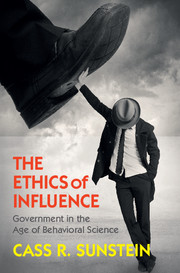Book contents
- Frontmatter
- Dedication
- Contents
- Acknowledgments
- 1 The Age of Behavioral Science
- 2 Choice and Its Architecture
- 3 “As Judged by Themselves”
- 4 Values
- 5 Fifty Shades of Manipulation
- 6 Do People Like Nudges? Empirical Findings
- 7 Green by Default? Ethical Challenges for Environmental Protection
- 8 Mandates
- A Very Brief Recapitulation
- Appendix A American Evaluations of Thirty-Four Nudges
- Appendix B Survey Questions
- Appendix C Executive Order 13707: Using Behavioral Science Insights to Better Serve the American People
- Index
2 - Choice and Its Architecture
Published online by Cambridge University Press: 05 June 2016
- Frontmatter
- Dedication
- Contents
- Acknowledgments
- 1 The Age of Behavioral Science
- 2 Choice and Its Architecture
- 3 “As Judged by Themselves”
- 4 Values
- 5 Fifty Shades of Manipulation
- 6 Do People Like Nudges? Empirical Findings
- 7 Green by Default? Ethical Challenges for Environmental Protection
- 8 Mandates
- A Very Brief Recapitulation
- Appendix A American Evaluations of Thirty-Four Nudges
- Appendix B Survey Questions
- Appendix C Executive Order 13707: Using Behavioral Science Insights to Better Serve the American People
- Index
Summary
Every government relies on coercion. Public officials forbid murder, rape, and assault. They impose rules to safeguard property rights and to make the highways safer (people have to drive on the right, or maybe the left), and people who violate those rules may well face a risk of jail. In numerous areas, officials mandate and they ban, even if they are generally and sincerely committed to freedom.
What's Coercion? Which Tools?
To be sure, the idea of coercion is far more complex than it first appears. When governments coerce people, they often do so by saying: If you act in ways that we do not like, you will face a risk of punishment. The risk might be large; maybe it is 100 percent, or close to it. The risk might be small; maybe it is 1 percent, or even lower. The punishment might be severe (the death penalty), or it might be lenient (a small fine). In any event, those who are subject to coercion usually face a choice: Obey the law, or face a penalty. Of course some people are subject to actual physical restraint. But most of the time, we say that people are “coerced” when they face a credible threat of punishment if they act in a way that officials dislike.
Government might avoid a threat of punishment and might speak instead of incentives. Some of those incentives are positive: If you engage in certain behavior, you will get a benefit, perhaps in the form of money. For example, those who buy fuel-efficient cars might be given some sort of tax subsidy. Some of those incentives are negative: If you want to pollute, you have to purchase a license, or if you engage in certain misconduct, you will have to pay a fee. The line between negative incentives and punishment is not altogether clear. If the goal is to discourage behavior, a very large fee might be more effective, and a lot more unpleasant, than a very small punishment. In fact a large fee might be a punishment. But if the government resorts to what it calls a punishment, it is usually trying to convey a strong message, which is that the underlying action is morally wrong.
- Type
- Chapter
- Information
- The Ethics of InfluenceGovernment in the Age of Behavioral Science, pp. 18 - 42Publisher: Cambridge University PressPrint publication year: 2016



